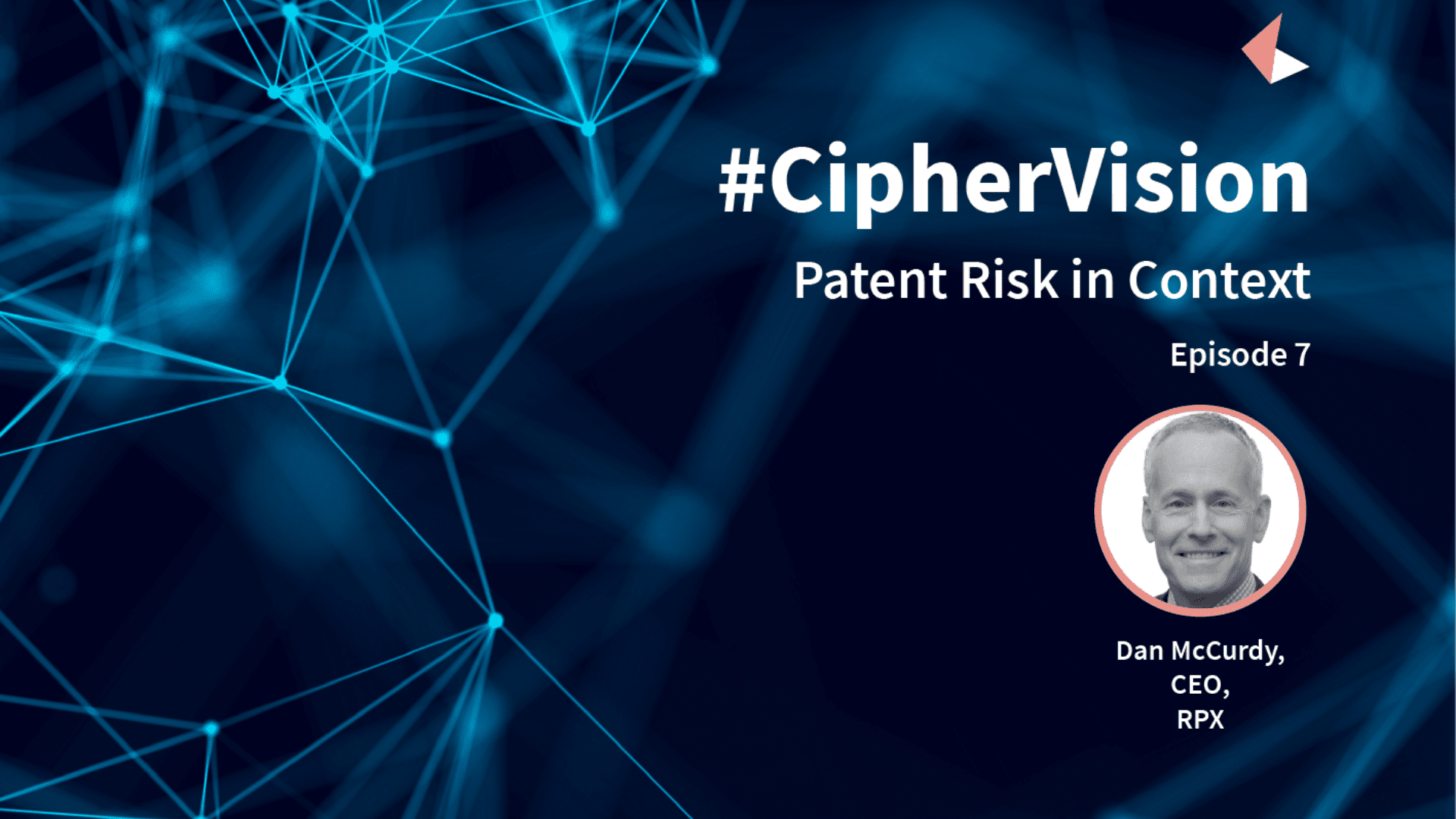Patent Risk In Context

This episode is about patent risk and the importance of risk strategy.
We were joined by an industry expert and the hosts of Cipher Vision podcast
- Dan McCurdy CEO of RPX Corporation
- Francesca Levoir Head of Marketing LexisNexis Cipher and podcast co-host
- Nigel Swycher CEO LexisNexis Cipher
Highlights of Patent Risk In Context Podcast
I started my career in IBM as an intern, and quickly moved from that through the company over a period of about 14 years, ending my career as the vice president of Life Sciences. And in that journey by serendipity, I ended up in intellectual property. When I was asked to become the manager of technology and intellectual property for IBM worldwide. And then I started a series of sort of entrepreneurial IP related ventures starting with Think Fire in 2001. And sort of ending with Allied Security Trust before I joined RPX.
What RPX does in the IP ecosystem
We have approximately 200 companies that are part of what we call our core membership. Most of the leading technology companies in the world, plus a number of automotive financial services. And even energy companies that are part of the of the RPX membership. We monitor emerging risks that involve patents. And once we identify them, we try and mitigate those risks by intercepting patents or obtaining rights to patents.
A positive force for negative right.
Patents are an unusual property. The ownership of a patent does not permit the owner to do anything except stop someone else from using the patented invention. And so by its very nature, it’s a negative and confrontational, right. Most people and companies who infringe intellectual property rights or patent rights, they’re completely unaware that they are infringing the right of someone else.
NPE and Patent Risk
RPX was born in 2008, around the NPE risk problem. And that’s a particularly difficult one, because even though NPE’s are not new phenomena. Historically, there was as much litigation, maybe more litigation per capita in America in the 1860s to 1880s, as there has been during the sort of peak of the modern NPE era. So patent owners, regardless of whether they’re operating companies, or non practicing entities are not a new phenomenon.
The only thing certain in the world where death, taxes and patent risk being a somewhat play on a quote by Benjamin Franklin. So patent risk has been around for a long time. NPE risk hasn’t been around forever, probably the 2000s were when it really got going. After all the legislative reform and case law that is beaten down on this activity by NPE’s, how has RPX continued to thrive.
Post the America Invents Act, there was a significant period of reflection, by the NPE community. If you took out for example, IP edge from the statistics that can file hundreds of lawsuits against specific defendants in a year. We remove the sort of outliers and look at the growth, I still expect that we’ll probably see growth of somewhere between 6 – 10% in 2021 in the US. The severity is a bit higher, because there’s so much due diligence that’s being done by the financial community before they invest in the litigation.
Change in NPE risk and patent risk
How do you see organizations managing that risk? What sort of risk mitigation strategies do you see them employing?
It’s not easy to generalize and certainly, across industries. The energy sector might face very different risks compared to medtech sector, semiconductor sector, than the automotive sector and so on. So it’s very difficult to generalize, I think the common theme should be that companies remain aware of where potential threats lie. And that’s largely an information and data related requirement. It’s obviously important to use excellent tools, we have some of our own, and others like LexisNexis Cipher. So one is awareness. The second is, is a mechanism to openly communicate, obviously, in a very pro competitive way, but to openly communicate with one another about what some of these risks and strategies are.
My suggestion would be to focus on the similarities and maybe not lean too heavily on the differences. The issues faced by a pharmaceutical company where one patent holds up a substantial portion of the profits is very different to a high-tech company where there are 1000s of patents in play.
What we are trying to learn from the risk survey, and from the interviews we’re doing is building on Suzanne Harrison’s work on IP strategy. The common framework could be developed to help companies categorize that risk. The results of the survey will be published in IAM.
Cipher Vision – Key Takeaway
We are in the middle of dispute after dispute, that seems to be never ending, we just really have a hard time stepping back to see the big picture. My prediction is there will not be any dramatic shifts with respect to at least patent related Policy. Many of the things that we have envisioned were going to heal the world from NPE’s or do great damage to patent implementers or somehow damage inevitably the rights of patent owners – almost none of those ever turn out to be true. The more things change, the more they stay the same.
Listen to the full episode of the podcast on Spotify, to feature as a guest or any feedback please reach out to [email protected]



